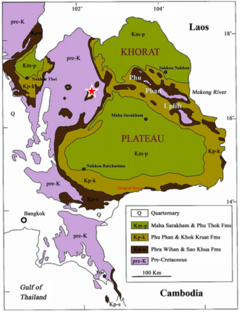| Khorat Group | |
|---|---|
| Stratigraphic range: Berriasian-Aptian ~ | |
 Location of the Khorat Group within the Khorat Plateau (Brown and yellow) | |
| Type | stratigraphic group |
| Sub-units | |
| Underlies | Maha Sarakham Formation |
| Overlies | Nam Phong Formation |
| Lithology | |
| Primary | Sandstone, mudstone |
| Location | |
| Region | Southeast Asia |
| Country | |
| Extent | Isan |
| Type section | |
| Named for | Khorat Plateau |
| Named by | Ward & Bunnag |
| Year defined | 1964 |
The Khorat Group is a stratigraphic group located within the Khorat Plateau in the Isan region of Thailand. It was first defined as the Khorat Series by Brown et al in 1953 and was redefined as the Khorat Group by Ward and Bunnag in 1964, which gave it its current constituent formations as well as including the Nam Phong Formation, which is now excluded from the group. Subsequently the sequence underwent several different stratigraphic proposals with several alternative divisions, but the formations proposed in Ward and Bunnag are the most widely used.[1] Initially thought to be Triassic, the sequence has been shown to be of Early Cretaceous in age, Dating from the Berriasian to Aptian. It overlies the Nam Phong Formation and is overlain by the evaporitic deposits of the Maha Sarakham Formation. It consists of continental freshwater deposits largely of alternating sandstones and mudstones.[2] The Group is notable for its fossil content, including those of dinosaurs.
- ^ Sattayarak, Nares (1983). "Review of the Continental Mesozoic Stratigraphy of Thailand" (PDF). Workshop on Stratigraphic Correlation of Thailand and Malaysia.
- ^ Racey, Andrew; Goodall, Jeffery G. S. (2009). "Palynology and stratigraphy of the Mesozoic Khorat Group red bed sequences from Thailand". Geological Society, London, Special Publications. 315 (1): 69–83. CiteSeerX 10.1.1.1030.8425. doi:10.1144/sp315.6. ISSN 0305-8719.